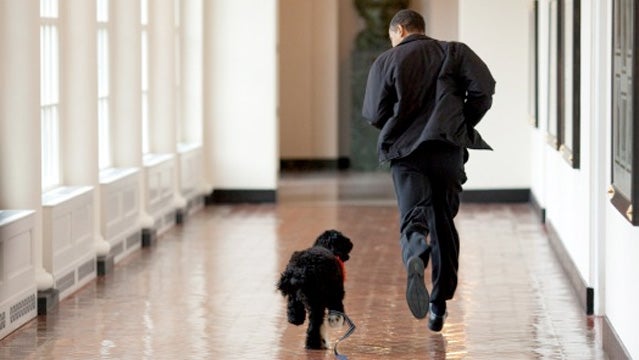After all the fuss over the Obamas’ choice of a dog—Portuguese water spaniel Bo, who was introduced in April of 2009—we were curious to see how the first family would train the little guy. Assistance Dogs of the West’s Sue Barns and I reached Bo’s trainer, Dawn Sylvia-Stasiewicz, in northern Virginia, where she runs Merit Puppy Training. Sylvia-Stasiewicz, 51, specializes in training pets in family situations. She’s worked with Senator Ted Kennedy’s dogs, Splash, Sunny, and, most recently, Cappy, who’s Bo’s littermate. She won’t talk about the Obamas or the White House dog specifically, other than to say, “It’s still a home; dogs are still dogs; and kids are still kids.” Here’s our conversation.
The Ultimate �����ԹϺ��� Companion
All you need to know about going wild with man’s best friend.What’s your basic training methodology?
I use positive reinforcement for the whole family. It works, it’s easy, and the kids can get involved.
Clicker training?
Clicker training. I sometimes hand clickers to students, but I understand it’s just something else in their hands. They’re still trying to get coordinated with a leash and hand signals. If they want one, they get one; if not, I don’t push it. I’m all about getting family working together with the dog.
Name some fun learning drills a family can do together with a dog.
There are all kind of things you can do in the framework of everyday life so you’re not out drilling the dog for an hour. We structure it so every interaction with the dog is both fun and a training scenario.
Retrieving: Even non-retrieving breeds can learn how to retrieve. And it happens really easily without a whole lot of effort. The dog runs out and grabs it and brings it to you and you say, “Good dog, have a cookie.” He’s going to start retrieving more and more. It’ll become a habit for him. Once you get that going, you can play hide-and-seek. You put the dog in a sit-stay, go hide his toy, and tell him to go find it. If he brings it back, you stuff it with food for him.
There are all kinds of things you can do. My daughter used a cash register with our border collie. She would hide a treat in there and train the dog to hit the buttons to get the treat.
What problems do you run into with kids and dogs?
There has to be supervision by parents all the time. Because I’m a professional trainer, my children watch me and naturally learn to interact with dogs. This never included any rough-and-tumble games that might lead the dog to overstep his bounds. Many times people don’t understand this. They let kids tumble with the dogs, and the kids don’t really know any better. We want parents to teach their kids that once a young dog or an untrained dog goes over the edge, it’s hard to bring him back. So you have to put that control in when you’re playing. I don’t recommend tug-of-war in the early stages of training, especially with kids, until you have complete control over the commands of the dog.
A famous trainer, Jon Rogerson, said, “expose your dog to everything. Find out what he likes, then control it, control the dog, and control the game.” That’s my philosophy; that’s what I like to live by; and that’s what I want families to learn. Later on you can play games like tug, but only when you’re in control of it. When you’re in control of the environment and the resources, that creates a very good relationship.
What’s your philosophy on treats and lures?
Luring is simply putting food in the hand that you will use on the dog’s nose to coax him into positions. It means you don’t have to physically position the dog. Rewards are always going to be a factor in the dog’s life, and we’re just saying, “Hey, control the rewards—make dogs work for them.” You hear people saying it didn’t work. That’s because they got rid of the food too quickly. They didn’t fade it out properly. Using food rewards is far quicker because they’re watching you before they’re ever listening to you. They know when you’ll be home on a Saturday or getting ready for work on a Monday.
Are there things you need to teach a dog that’s going to be in the public eye that you wouldn’t teach to a normal dog?
There are very strict regulations that you have to follow in that environment. It’s an enormous responsibility to train the dog like a citizen. When I work with someone, we get the dog out and work in public, teach him to sit, how to walk on the street when people are going by, going through doors, and how to greet people. When I have clients who will be out in the public a lot, we work out in the public a lot—privately.
Do you expose them to microphones and flashbulbs?
You just need to get the dog out in public and use food to keep them focused on you and the task at hand. It doesn’t take very long. Go for short amounts of time, and make it fun. Some dogs may need a little more work in those areas, but I’ve been fortunate in that most of the dogs I’ve worked with were good temperamentally.
Sounds like you don’t get a lot of dogs with fear issues.
I’ve had dogs come into my classes with fear issues. There are two options: you can work with the dog and make is easy for them to feel comfortable here, or you can force the issue, and I don’t go there.
So a gradual desensitization?
Yes. Keep a dog busy and focused on the owner such that the dog doesn’t have time to go on his own program and think, Oh, that’s scary. We keep the dog’s mind busy and focused on the task.
Would you say that everyone makes the same training mistakes with their first dog?
I don’t know if everybody does. These days it’s a little different because positive reinforcement has moved to the forefront and owners have a choice. Back when I started, positive reinforcement was underground. I attended many classes where I had to hide my food and sneak it to the dog. I had a Portuguese water dog. I learned through her to make the transition to food. It was difficult because she already had a negative image about training. She didn’t like the leash; she didn’t like the collar; and she didn’t know how to work for food. I had to clear out those things. It took me about 18 months to retrain her. I basically stopped competing, stopped going to classes, and I got involved in agility for fun, some tracking for fun, and, through food, I got her going again.
Is there something you like about the Portuguese water dog?
They have a good temperament. They’re described as good family dogs—good with children. A lot of breeds out there are described that way, so that’s where you have to screen your breeders very carefully and make sure that they’re qualified and have a good reputation. Also, there are allergies in my family, and so I like the fact that they were considered unlikely to cause allergies. I don’t think there is any dog out there that actually allergy-free, but they’re considered a better bet. What people don’t realize with a non-shedding breed is that there’s a higher grooming requirement. It’s a nightmare. People forget.
Have your classes become more popular as of late?
There’s been a lot of interest, which is good. I’m really surprised how many people out there aren’t familiar with clicker training and positive reinforcement. It amazes me that so many people don’t know about Dr. Ian Dunbar. His book was the first I read about positive reinforcement and animal behavior, and it was written in such a way that it was easy to understand for someone just getting into it.
Why are some people still so resistant to using food for training?
A couple of years ago, I had a few people sign up for my class who saw that I was using food and they said, “Well, I don’t want to do that. That’s OK for puppies, but that’s not real dog training. You have to slam them around or push their rump.” But this is real dog training. We’re just taking a different route. Both methods are going to get you a trained dog, but it’s a personal choice about how you want to get there and which road you want to take. I prefer the method that I’m using. I feel better using it. I was also a non-spanking parent.
What about the common assumption that a dog is just disobeying?
People are quick to call a dog stubborn—say: “He knows how to do this. There’s something wrong with him.” I don’t like to call a dog stubborn. Some might be more independent thinking; some might be a little more spirited or have high energy. I don’t like to use labels because once you put a label on a dog, people emphasize the negative for some reason. It’s the way we were raised: “How can I fix this problem.” I don’t think it’s a matter of correcting it; it’s a matter of replacing it with something else incompatible with what they want to do—something desirable. People get focused on what the dog is doing wrong rather than paying attention to what they want the dog to do instead.
This article originally appeared on �����ԹϺ��� K9, the former dog blog of �����ԹϺ��� magazine, on May 26, 2009.


